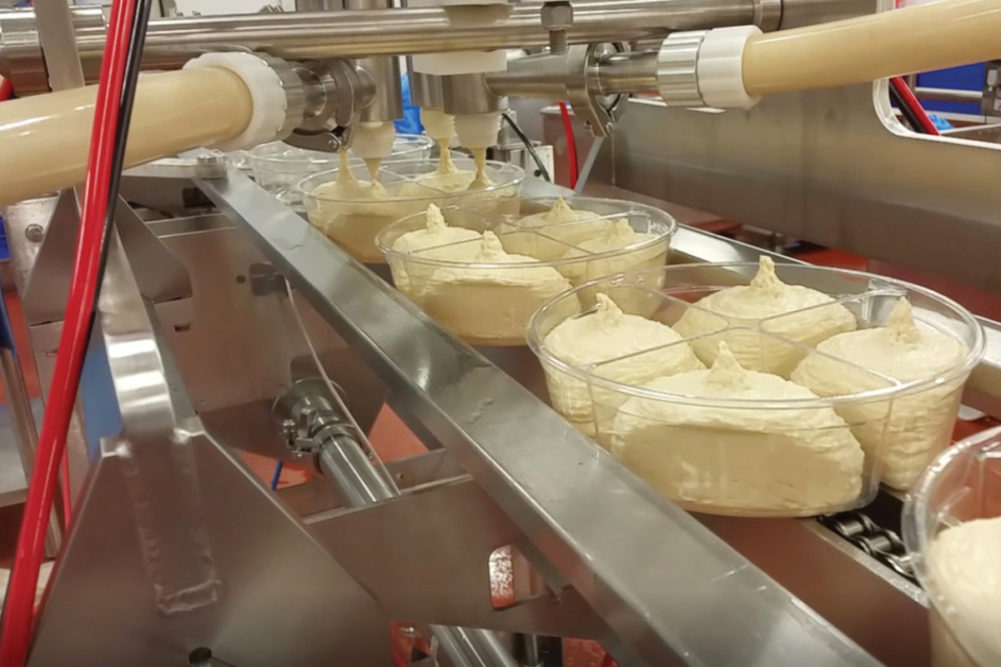KANSAS CITY - More and more, grocery stores are turning to commissaries, central kitchens and other offsite facilities to meet their needs for prepared foods and other foods sold in the fresh perimeter, said Terry Neithercut, business development manager for Delta, B.C.-based Unifiller Systems Inc.
Unifiller works with retailers closely to upgrade any equipment that has been supplied at the store level so it can work at the commissary level, she added.
“Our solutions are modular and easy to 'step up' automation for larger volumes. Unifiller's goal is to fully understand the needs of our customers—run sizes, volumes, particulates, etc. —to make sure that the solution provided fits the business.”
Popular solutions from Unifiller for commissaries include the company’s Universal 1000i, Universal 2000i, Low Level Kettle Direct, Transfer Pumps and other units. And while commissary customers often don’t share equipment between bakery and food production, due to layout issues, Unifiller equipment is versatile enough that it can be shared by different departments, Neithercut said.
Unifiller equipment is used extensively for portioning deli items in both commissaries and fresh perimeter departments, Neithercut said. The company’s solutions focus on flowable products: soups, chili, salsa, dips, hummus, and sandwich fillings like egg salad and potato salad.
Most fresh departments, he added, need a depositor that’s versatile (equipped, for example, with change attachments to handle a wide variety of products) and easy to sanitize and switch over, since products are usually shelf-dated and produced in small runs.
Unifiller is constantly tweaking its lineup, Neithercut said. Recently, for example, the company developed a spray nozzle that’s perfect for portioning or spraying thin layers of pizza sauce, mayonnaise and other products.
Solutions like those provided by Unifiller are increasingly important to supermarkets and commissaries for many reasons, including accurate portion control and the ability to do more with less staff, Neithercut said.
“Many of our customers report that it is difficult to attract and retain staff for simple tasks like portioning,” he said.
Packaging’s role
In addition to depositor technology, packaging plays a huge role in portion control in the commissary/central kitchen and other retail food channels.
Market demand for portion control, for instance, has driven the product development team at Shelton, Conn.-based Inline Plastics to design products to accommodate the growing need for single serve and pre-packaged snack and meal options, said Cindy Blish, the company’s associated brand and communications manager.
“The trend of practicing portion control has been changing over the last several years and even more so since the onset of the pandemic,” Blish said. “The snacking industry has been witnessing a significant increase in demand with most demographics. We see younger shoppers, mainly millennials, who tend to consume smaller meals during the day and snacking frequently and sometimes snacking replaces or even becomes the meal.”
During the pandemic, the numbers also show an increase in those indulging in sweet snacks, Blish added, which increases the need for smaller size, grab n’ go, portion control type of packaging.
With pre- and post-pandemic trends evolving, Inline has significantly broadened its offerings of single-serve packaging and containers with multiple compartments. Multi-cell packaging gives retailers the flexibility to offer different food combinations that ultimately become pre-packaged meals.
In addition, Inline’s line of tamper-evident, tamper-resistant packaging, Safe-T-Fresh, has added the Snackers and SnackWare lines of grab-and-go multi-cell products. With these options, it’s easier for commissaries or retailers to package a sandwich wrap paired with sliced apples or other complementary foods, Blish said.
To assist both processors and retailers prepare grab-and-go salads with different assortments, Inline just added new “Flip n Mix” tray Inserts with two and three compartments to hold various toppings and dressings that are designed to sit within Inline’s tamper-evident rectangle containers. These inserts add a new dimension to consumers’ choices in the same package, Blish said.
The biggest drivers today behind the movement toward portion-control-focused packaging include the growing need for more grab-and-go options as well as the huge increase in take-out orders and deliveries, Blish said. During transport, it’s vitally important that the packaging is able to maintain the integrity of the contents.
“The tamper-evident characteristics of Inline products has been among the key criteria and top of mind for both retailers and consumers alike when choosing foods and food packaging,” Blish said. “These packages change hands any number of times before they reach their destination and must remain safe and secure from both contamination and tampering.”

